You carry a beautiful plant into your home. You tuck it into a bright corner, water it with care, and imagine how lush it will look in the background of your photos when people come over for the holidays…
Then…the leaves yellow. The edges crisp. Within weeks, your “showpiece” sits in what’s become the dank corner of your otherwise beautiful space.
Most homeowners will blame themselves, but this is not always a case of over-watering or neglect!! If you’ve EVER resigned to think, “I have no green thumb,” then you’ve quit too soon. Sometimes it’s the home itself that stops certain plants from thriving. HVAC systems dry out the air far more than you realize!! And that perfect window you thought offered sunshine?! It might blast too much heat in summer…or a chilling draft in winter. Either of which will damage certain plants.
And, most importantly, some plants are not ideal for use indoors as part of your interior design.

This is why knowing which plants actually thrive indoors is essential. With the right selection, you gain EVERYTHING that biophilic design promises: a healthier home, natural beauty you enjoy every day, and greenery that looks intentional and WOWS people rather than “plopping something in a pot.”
And now, here’s the interiors-focused guide to the best plants for indoors!!
Monstera Deliciosa
Monstera, sometimes called the “Swiss cheese plant,” is popular for its enormous, glossy leaves with natural cut-outs and slits. In the home, it can easily grow to six or seven feet tall. Talk about a tropical look!!
Design potential:
A Monstera makes a statement. Imagine one in a large basket planter beside a neutral sofa: the rooms lines are instantly softened! You could even let one climb a moss pole installed in a dining space to create a green backdrop for entertaining…or, for something TRULY unexpected, style it near a mirror: the sculptural leaves reflected back will double its lushness!!
Care requirements:
- Keep soil lightly moist, but not soggy
- Bright, indirect light; avoid harsh direct sun
- Provide a moss pole or trellis for vertical growth
- Wipe leaves occasionally to keep their natural sheen
Monstera is commonly sold at garden centers and big-box home stores, and of course at specialty nurseries. It grows quickly inside, so expect visible new leaves every few weeks if conditions are right!
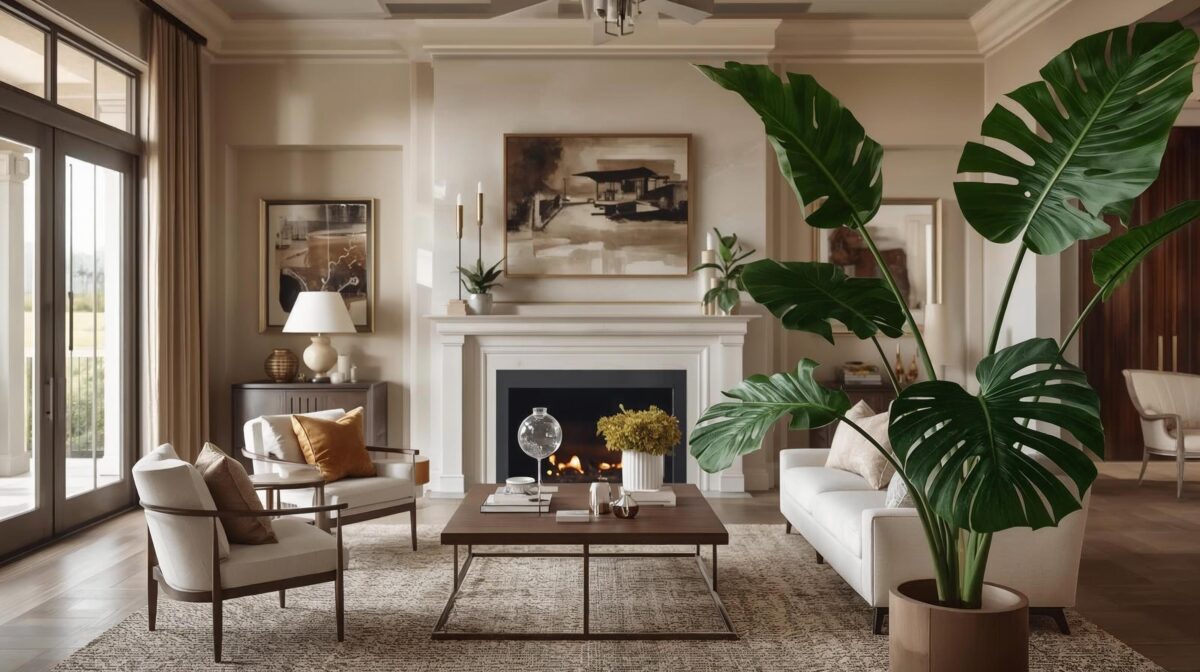
Pothos (Epipremnum aureum)
Pothos is one of the easiest vines to keep indoors. (Yes, vines indoors can be an INCREDIBLE addition!) Its heart-shaped leaves are naturally streaked in gold, cream, or white, and its trailing stems can grow ten feet or more…
Design potential:
Most people hang pothos in baskets or let them spill out from shelves, but you can take it sooo much further. Train its vines up a wall using discreet hooks to create a living accent that frames a doorway. (Wow!) Or, drape it along the top of kitchen cabinets to soften the edges of your cabinetry. In a home office, a pothos trailing across bookshelves turns functional storage into a downright inspiring backdrop!
Care requirements:
- Low to bright indirect light
- Water when the top inch of soil is dry
- Trim vines to control shape and encourage fullness
- Almost impossible to “kill,” making it a favorite for beginners
Sold everywhere from grocery stores to nurseries, pothos is fast-growing and quite inexpensive. A cutting placed in water will root within weeks, so it’s also easy to propagate.
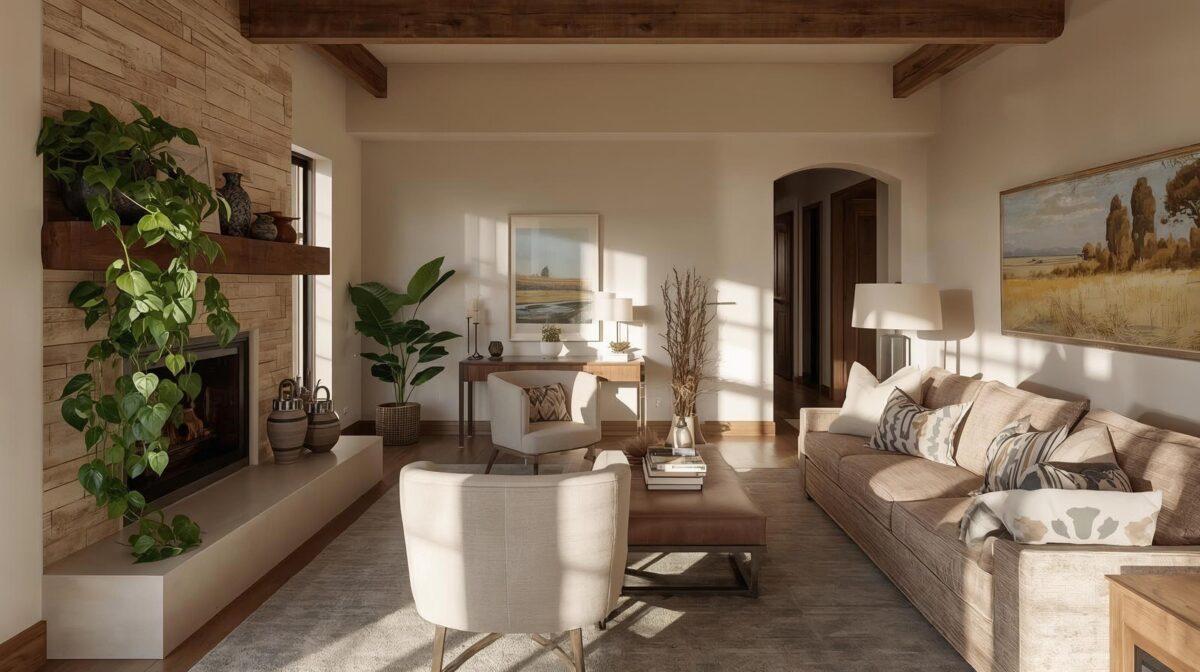
Fiddle Leaf Fig (Ficus lyrata)
This plant with potential is tall, architectural, and theatrical. The fiddle leaf fig has violin-shaped leaves that are large and medium green. Indoors, it can grow from five to ten feet. (Oh my…)
Design potential:
Place one of these in a tall planter in your entryway and it will greet guests with grandeur! In a living room, it can anchor a corner just like an art statement piece could. Or, you could style two together as “living columns” on either side of French doors, especially doors that lead outside, to create an unforgettable indoor-outdoor connection!!
Care requirements:
- Bright, indirect light
- Avoid drafts and sudden relocation
- Rotate regularly for balanced growth
- Water when the top two inches of soil are dry
These are easy to find at nurseries and higher-end garden centers, though they are pricier than other houseplants. They’re slower to mature, but worth the investment for their Return On Enjoyment®.
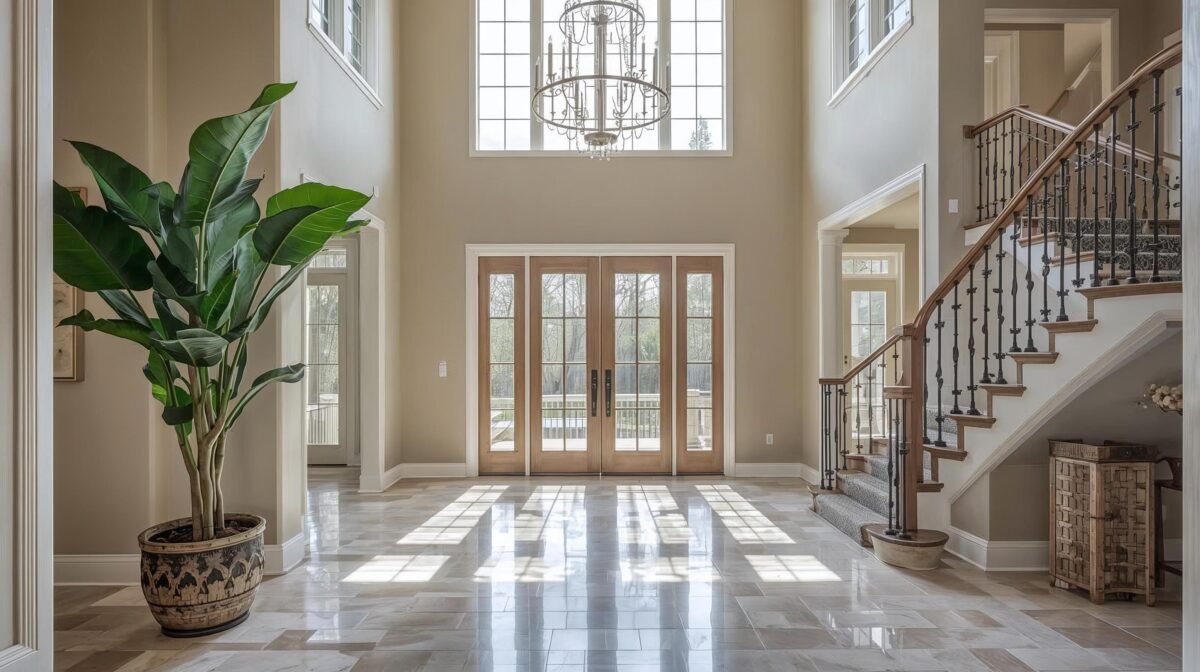
Kentia Palm (Howea forsteriana)
The Kentia palm is a classic indoor palm. Its long and arching fronds give you a look of quiet elegance. It grows slowly, but can eventually reach seven to ten feet in height.
Design potential:
The Kentia Palm is perfect for softening a corner or adding vertical height where artwork alone feels flat. In large or open-plan spaces, use a Kentia to “frame” zones, like subtly separating a dining area from a living space. Its airy fronds also pair beautifully with floor-to-ceiling windows for that resort-grade effect…
Care requirements:
- Medium light is best
- Keep soil evenly moist, not soggy
- Tolerates dry air better than most palms
- Dust fronds occasionally to maintain luster
Available at specialty nurseries or higher-end suppliers, the Kentia often comes at a bit of a premium. Because they’re slow-growing, purchasing a larger specimen upfront gives you more instant impact.
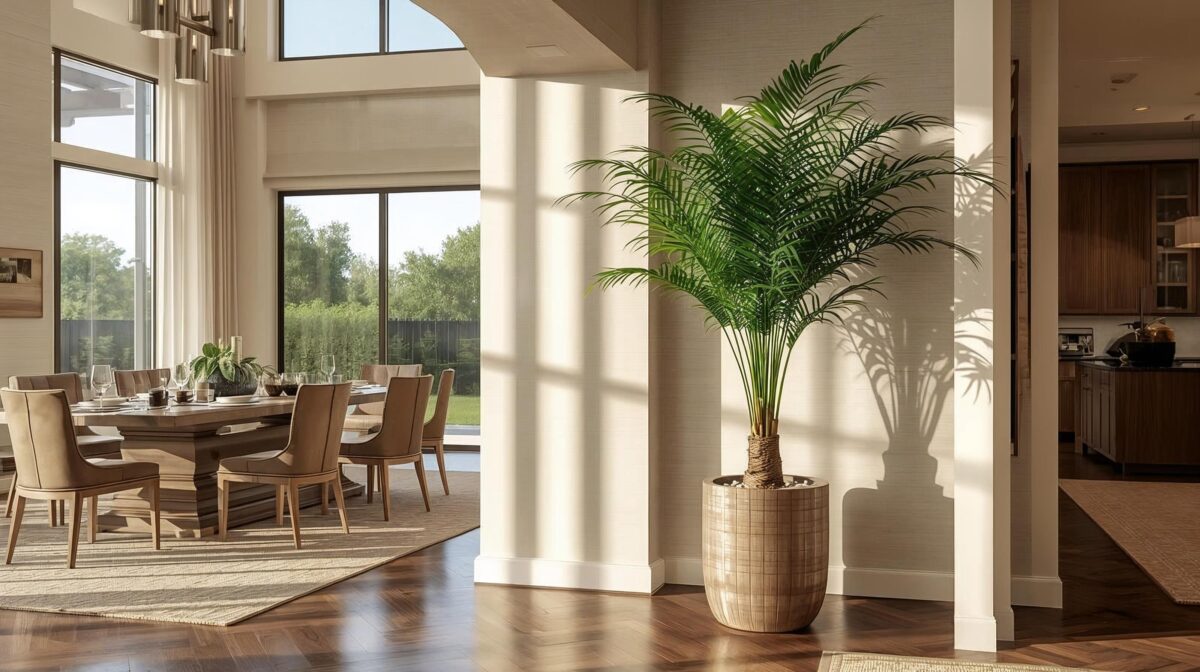
Snake Plant (Sansevieria/Dracaena trifasciata)
Known for its sword-like, upright leaf that’s “banded” in green and yellow, the snake plant is a true sculptural addition! Depending on the variety, it can range from one to four feet tall.
Design potential:
Its clean vertical lines complement modern interiors well. You can use several in varying heights together for a “forest of spears” effect. Or, you can flank a media console with two tall snake plants instead of lamps…
Care requirements:
- Practically indestructible
- Tolerates low to bright light
- Extremely drought-tolerant; water sparingly
- Great for bedrooms (releases oxygen at night)
Sold in every nursery and even grocery stores!! Growth is slow, but their longevity and minimal care make them one of the best for use in décor.
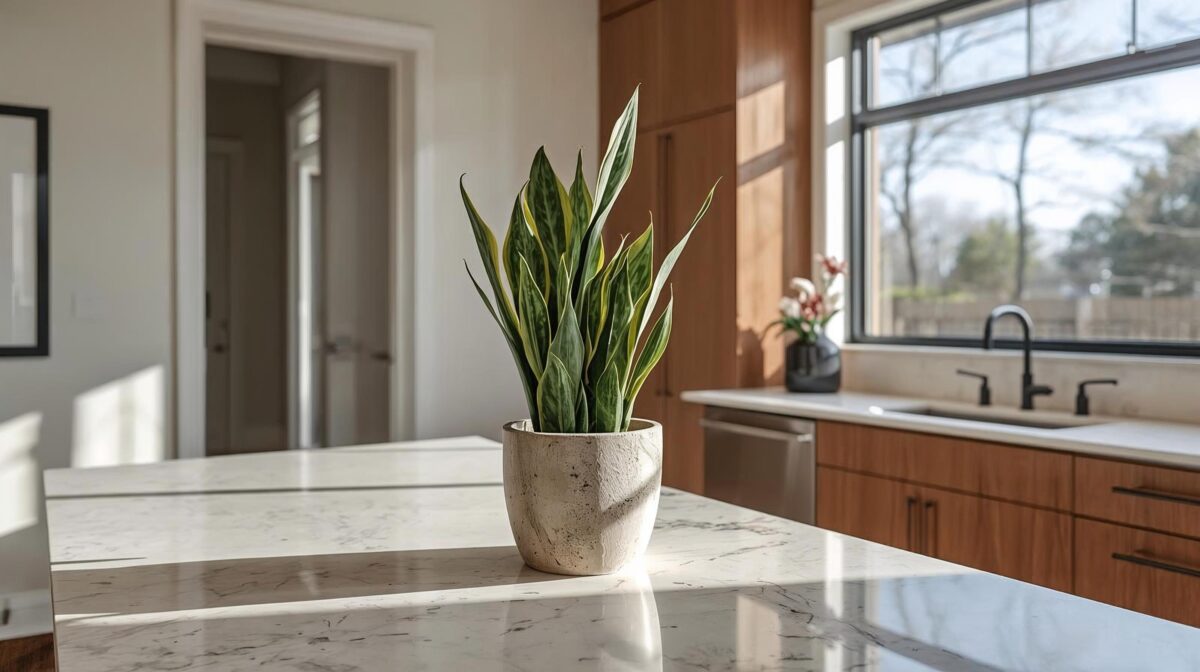
Spider Plant (Chlorophytum comosum)
Look at the spider plant’s arching, striped leaves, and you can appreciate its playful look. These cascading beauties grow about a foot tall and produce plantlets on trailing stems that can reach several feet in length.
Design potential:
The spider plant does best in hanging baskets, where their plantlets dangle like costume jewelry. For a different twist, use a low, wide planter on a console table and let the plant spill over the edges. Or, try clustering several spider plants together at varying heights for a canopy-like texture.
Care requirements:
- Bright to medium light
- Trim brown tips as needed
- Water moderately; don’t let soil stay soggy
- Propagate new plants from the “babies” and hand them out to friends!!
These are extremely common, and therefore affordable. Spider plants are also one of the fastest to grow and replenish themselves, making them easy to integrate quickly into multiple spaces.
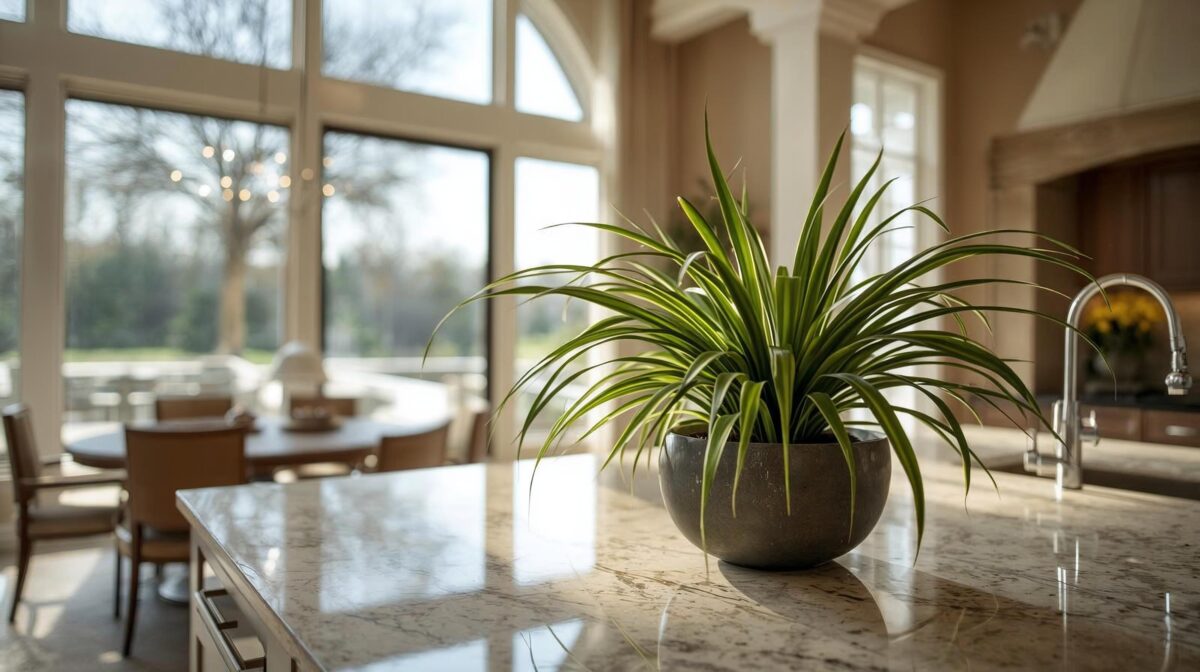
Peace Lily (Spathiphyllum)
With its deep green leaves and beautiful white blooms, the peace lily is calming and striking! Mature plants grow to between one and four feet tall.
Design potential:
Peace lilies thrive in spaces where other plants sulk!! For instance, they can brighten a bathroom vanity or add polish to a bedroom nightstand. For a more luxurious idea, place several in identical planters down a hallway for a rhythmic, spa-like look.
Care requirements:
- Tolerates low light
- Keep soil evenly moist
- Benefits from occasional misting
- Remove spent blooms to encourage new growth
Widely available, these are often sold as a “gift plant” in florist shops. They’re affordable and reliable bloomers, especially in the springtime.
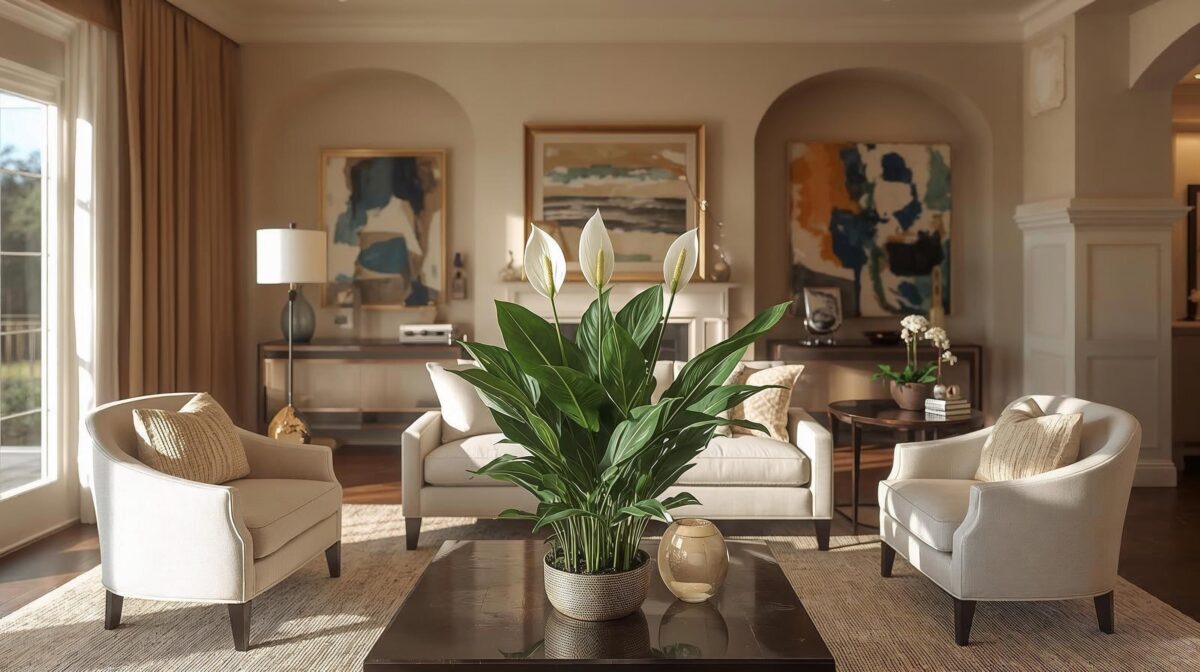
Ficus Benjamina (Weeping Fig)
This is another classic indoor tree with glossy leaves and a graceful arch. It typically grows four to eight feet indoors.
Design potential:
The weeping fig is essentially a living sculpture! Use it in transitional spaces, like the corner of a hallway that opens into a living room, where it can soften the architectural lines. For something really unexpected, style one in a minimalist planter against a bold wall color to create contrast.
Care requirements:
- Bright, indirect light
- Sensitive to relocation or drafts
- Water when the top inch of soil is dry
- Regular pruning helps maintain shape
Easy to source at nurseries, the weeping fig is slightly harder to find than its flashier cousins. Once established, however, it can live decades in the same home.
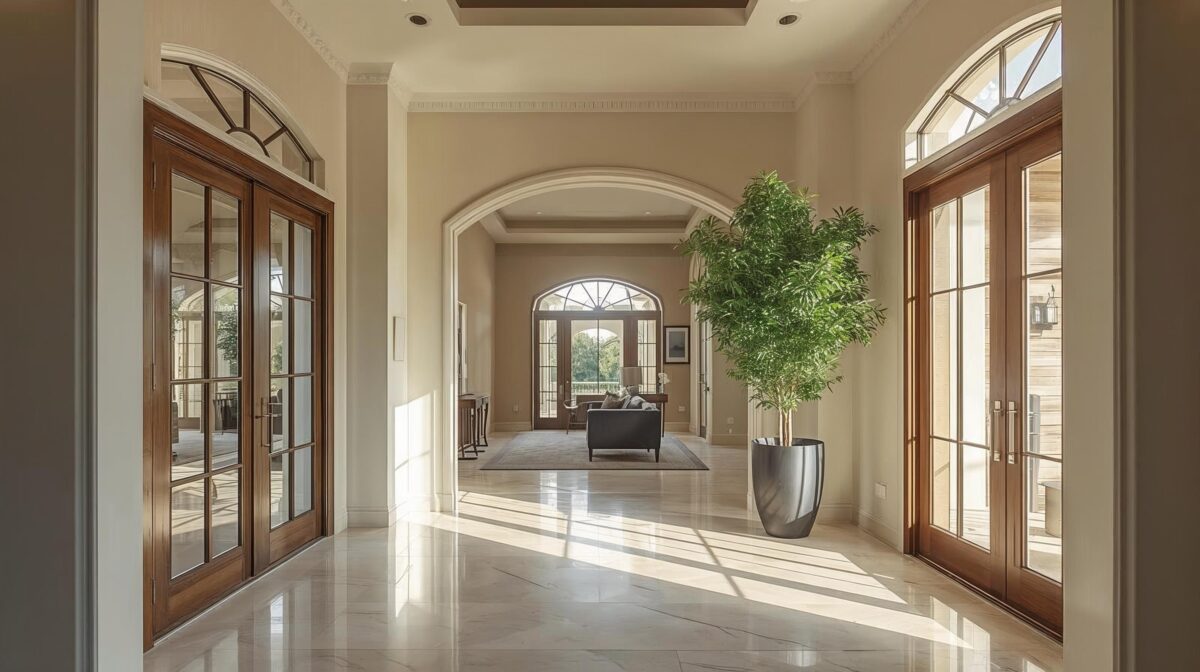
Philodendrons (various types)
Philodendrons come in many forms, from trailing heart-leaf types to more dramatic split-leaf looks. In your home, they can grow to be between one and six feet tall.
Design potential:
Use trailing philodendrons on open shelving for that cascading effect. Larger split-leaf types are perfect for anchoring an empty corner with bold foliage. Or, for a clever idea you won’t see in anyone else’s home: mix philodendrons of different shapes in the same space for a botanical gallery.
Care requirements:
- Moderate watering
- Medium to bright indirect light
- Rotate regularly for balanced growth
- Support climbing types with a trellis or pole
Readily available in nurseries, with many varieties sold as starter plants. They’re fast growers, so you’ll see results quickly!!
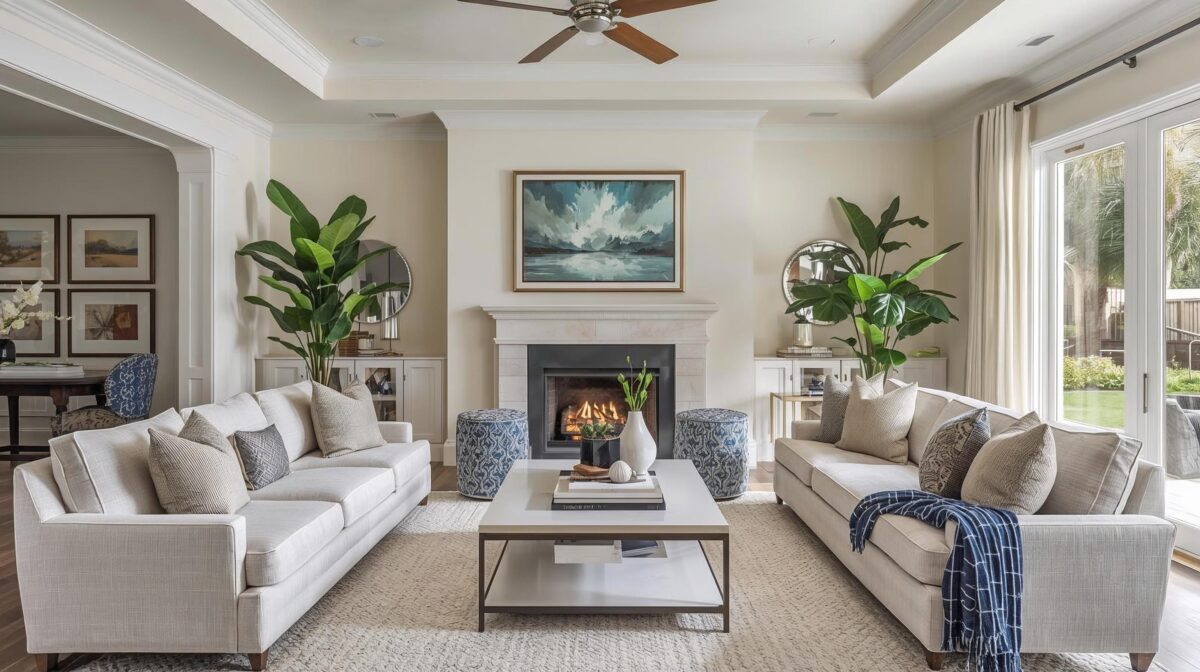
Aglaonema (Chinese Evergreen)
Aglaonema has beautifully patterned leaves giving you shades of green, silver, and even red to play with!! Its form is compact, staying around one to three feet tall.
Design potential:
This plant is perfect for brightening low-light corners where few other plants could thrive. Its colorful foliage can act as a natural accent, too, just like a throw pillow or art piece, especially in neutral environments. Try setting one in a sleek ceramic pot beside a reading chair for instant visual lift…
Care requirements:
- Avoid cold drafts
- Tolerates low light
- Water when top 1–2 inches of soil are dry
- Occasionally dust leaves for best appearance
These are easy to find at big-box stores and nurseries. Aglaonemas are slow to moderate growers, but their vibrant foliage keeps them looking fresh year-round.
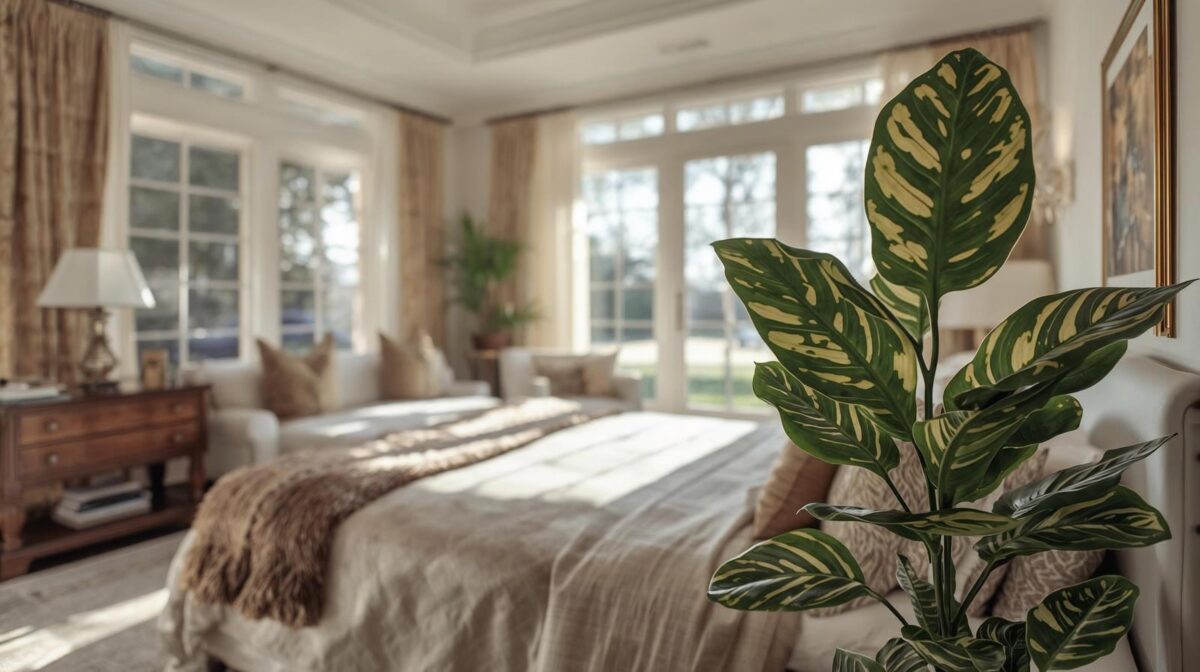
Ferns (Boston, Maidenhair, Bird’s Nest…)
Ferns bring a feathery texture to your interiors! Most varieties stay around one to three feet tall, but always with lush clumps of fronds.
Design potential:
Ferns thrive where others fail: humid bathrooms and kitchens!! Imagine a Boston fern suspended near a shower window…or a bird’s nest fern in a decorative pot on your kitchen island in contrast with the hard surface. They’re also stunning in clusters for that layered texture look.
Care requirements:
- Indirect light
- High humidity
- Keep soil evenly moist
- Avoid direct drafts from HVAC
Very common at nurseries, these are often sold in hanging baskets. They grow quickly when conditions are right, making them rewarding for homeowners who properly maintain indoor humidity.
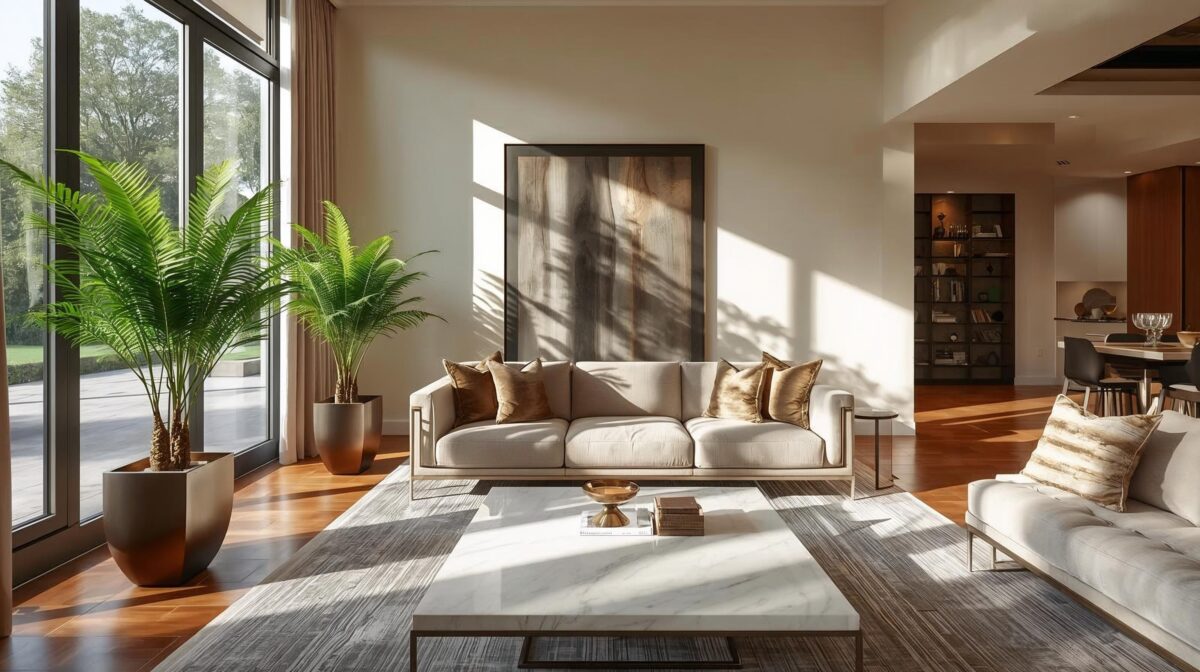
Air Plants (Tillandsia)
Air plants are sculptural plants that don’t need soil!! They range from a few inches to nearly a foot and sport spiky and curly foliage.
Design potential:
Their versatility is truly unmatched. Suspend them in glass orbs in front of a window…mount them on driftwood for a natural art piece…or arrange several in a shallow bowl on a coffee table. They can even be worked into custom light fixtures for a living design element. Wow!!
Care requirements:
- Bright, indirect light
- Ensure good airflow around the plant
- Mist 2–3 times weekly or soak briefly once a week
Air plants are sold in specialty plant shops, garden centers, and widely online. They grow slowly but last for years with the right care.
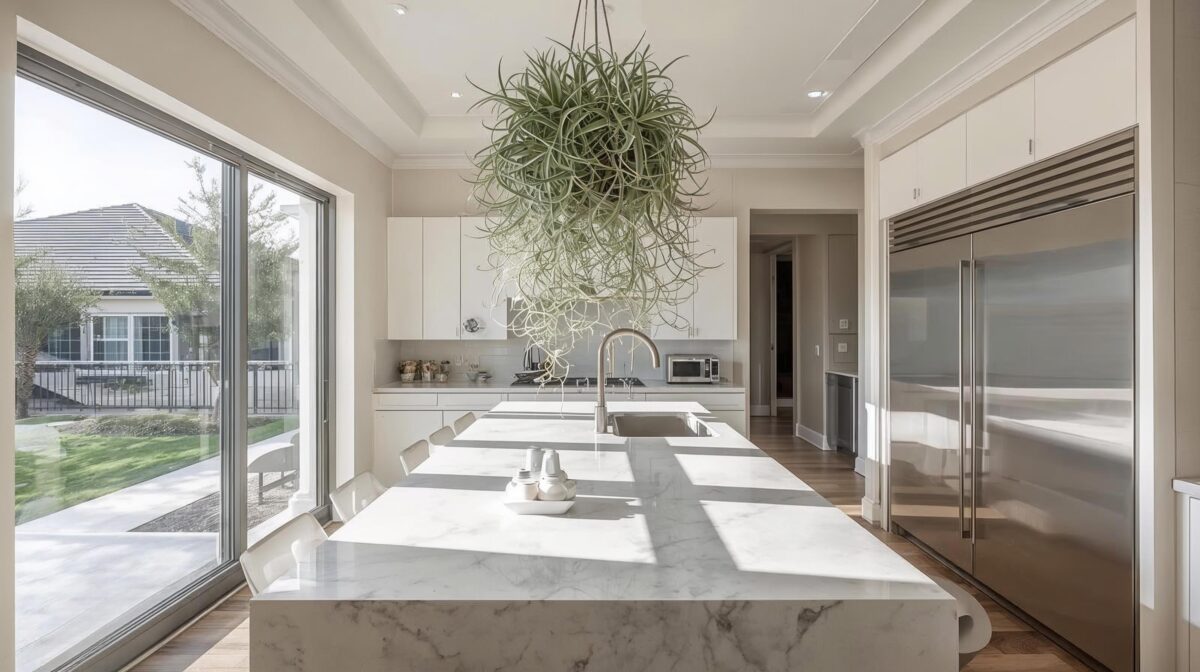
Rubber Plant (Ficus elastica)
The rubber plant has a characteristic glossy leaf that you’ll see in either deep green or burgundy. Indoors, it can grow four to eight feet tall.
Design potential:
The rubber plant’s thick leaves and strong vertical growth make it perfect for anchoring a seating area, office, or study. For a truly spellbinding look, style one in a tall matte planter beside a large mirror…the reflection doubles the presence of its sculptural foliage.
Care requirements:
- Water when soil dries halfway
- Wipe leaves to remove dust
- Repot when rootbound
- Bright, indirect light
Widely available in nurseries, rubber plants come in multiple color variations. Growth is moderate, but large specimens make an immediate impact.
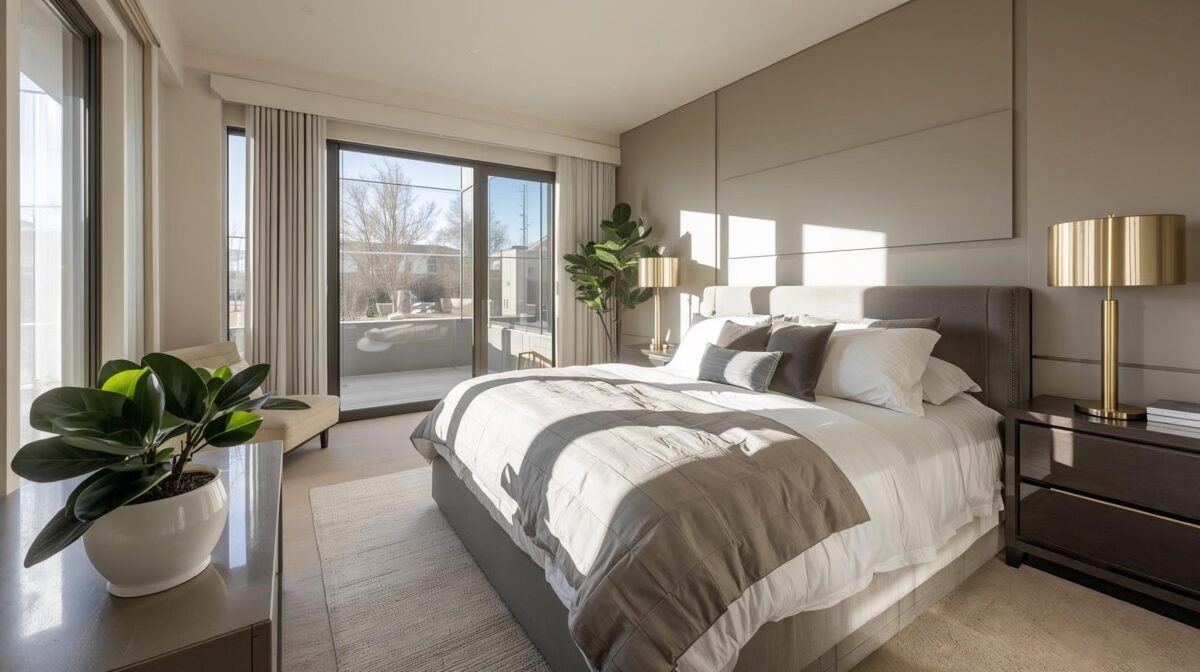
What to Know About Biophilic Design…
You’ve probably heard the term biophilic design a LOT more often the last few years. It’s not just another trend, either: it’s a movement that reflects our deeper need to connect with nature in the place where we spend most of our time!!
Just think: modern homes are climate-controlled boxes with filtered air, artificial lighting, and sealed windows. Beautiful…but they can leave us detached from the natural world. Biophilic design reintroduces those natural connections through materials, light, textures, patterns, and even smells and air quality. And unlike fleeting styles (looking at you, all-gray interiors of the early 2000s…), this movement is timeless.
A little goes a long way. Learning just enough to choose an indoor plant and integrate it now can pay off for years with what we call Return on Enjoyment®. When design delivers beauty and daily well-being, that’s a return that doesn’t fade with fashion!!
Which plant feels most you?! Try one today and notice how alive your home feels…
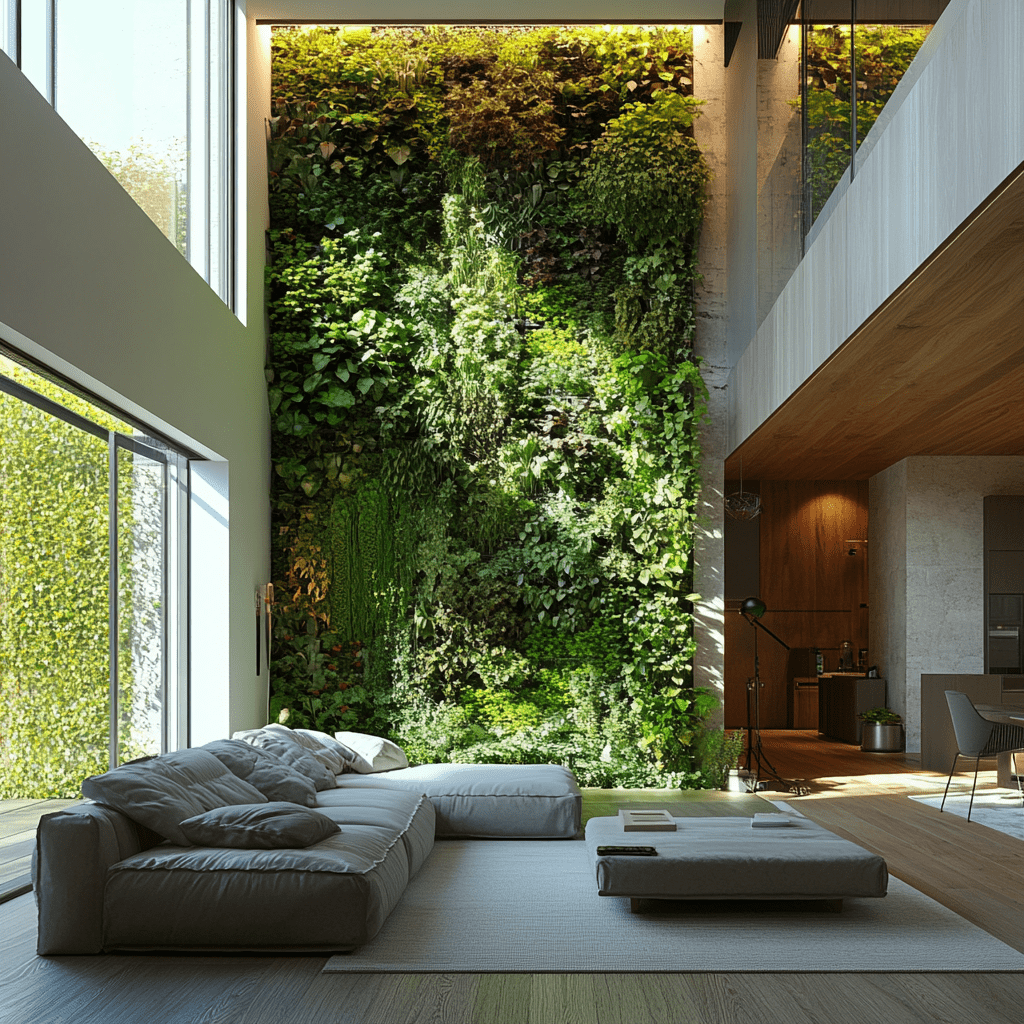
About the author:
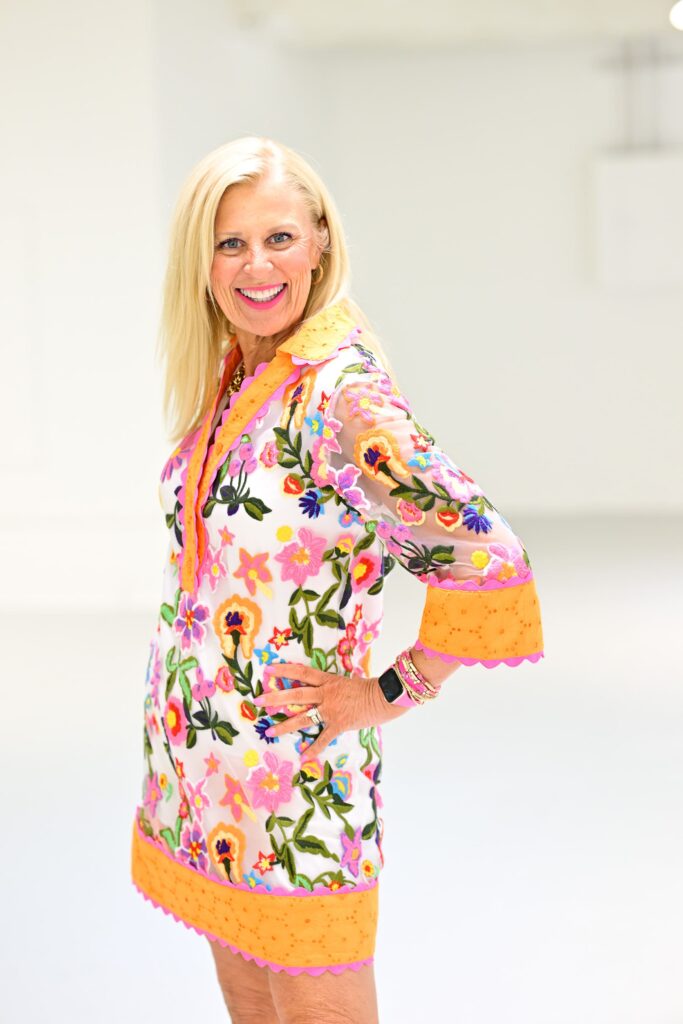
Robin Burrill, RID, NCIDQ, ASID, IDS, CAPS, is an award-winning professional kitchen, bath, and interior designer. Robin and her husband, Robert Mathews, have owned Signature Home Services, Inc. for over three decades, establishing a superior in-house team with a widespread reputation for delivering meticulous design to their many repeat clients.
In 2022, the national publication, Kitchen and Bath Design News magazine, named Robin to their Top Innovator list in recognition of her achievements in the field of kitchen and bath design. In 2024, she was named one of the Fall 2024 Market Pros and “tastemakers” by ANDMORE at High Point Market. Also in 2024, Fixr identified her as one of the Top Professional Interior Designers for their nationwide audience. At the start of 2025, she then acted as one of Dallas Market’s “Style Eyes” at Lightovation and Total Home & Gift Market.
Over her extensive career, Robin has been quoted in Architectural Digest and Forbes multiple times; her design work has been featured in top national trade publications; and she has been interviewed for Designers Today magazine’s “Profiles in Design” video series, among others. Widely respected for the depth of her knowledge, Robin is a sought after speaker and judge for many design industry events.
In 2023, Robin designed a bench for Charleston Forge, making her foray into product design. Robin currently serves as a volunteer on the board of the Dallas/Ft. Worth chapter of the Interior Design Society.

Leave a Reply